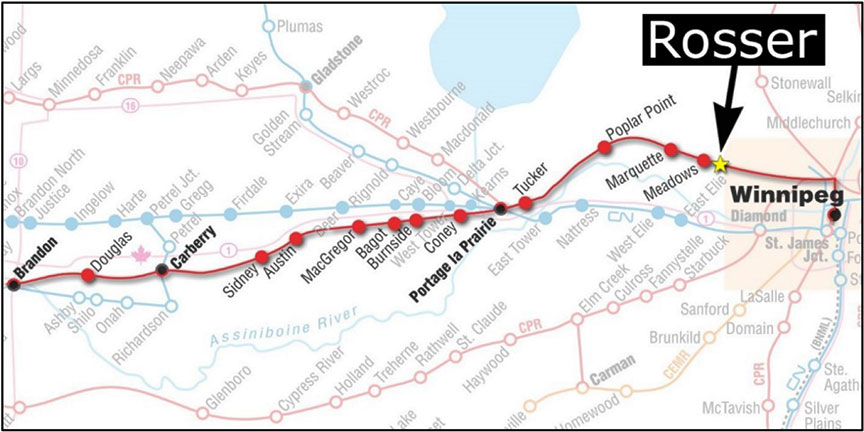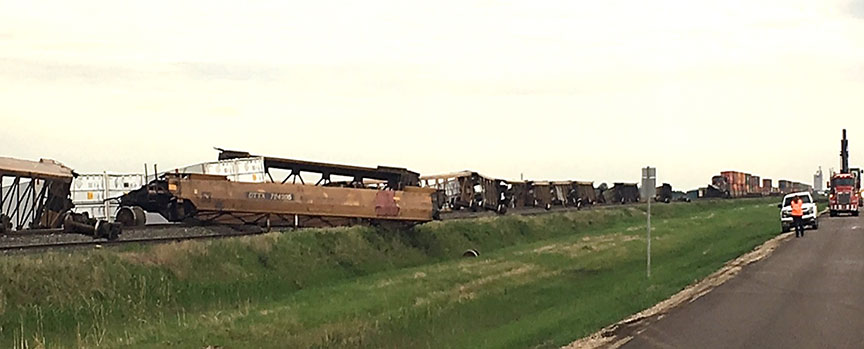Main-track train derailment
Canadian Pacific Railway
Freight train 112-27
Mile 13.4, Carberry Subdivision
Rosser, Manitoba
The Transportation Safety Board of Canada (TSB) investigated this occurrence for the purpose of advancing transportation safety. It is not the function of the Board to assign fault or determine civil or criminal liability. This report is not created for use in the context of legal, disciplinary or other proceedings. See Ownership and use of content. Masculine pronouns and position titles may be used to signify all genders to comply with the Canadian Transportation Accident Investigation and Safety Board Act (S.C. 1989, c. 3).
The occurrence
On 29 May 2018, a Canadian Pacific Railway (CP) operating crew was ordered at 1450Footnote 1 for intermodal trainFootnote 2 112-27. The crew was to operate the train eastward on the CP Carberry Subdivision from Brandon, Manitoba (Mile 133.1), to Winnipeg, Manitoba (Mile 0.0). The crew consisted of a locomotive engineer (LE) and a conductor, who were qualified for their positions, met fitness and rest requirements, and were familiar with the territory.
The train was powered by 3 locomotives: 1 head-end locomotive (CP 8764), 1 mid-train locomotive (CP 9763), and 1 tail-end locomotive (CP 9784). The train consisted of 30 loaded intermodal cars (transporting 107 loaded containers and 38 empty containers), 1 empty intermodal car, and 11 loaded auto cars. The train was 6275 feet long and weighed 5141 tons.
At 1517, the train departed Brandon, destined for Winnipeg. At approximately 1735, while proceeding near Rosser, Manitoba (Figure 1), the LE slowed the train to 25 mph to comply with a Rule 42Footnote 3 General Bulletin Order (GBO) issued to a track foreman working in the area. Once the train had passed through the foreman's limits, it encountered a severe thunderstorm with heavy rain. The storm limited the crew members' ability to positively identify the next signal and they were unable to hear each other in the locomotive cab due to the noise generated by the storm. Consequently, the LE kept the train at the reduced speed of 25 mph.
At 1743:53, while travelling at 22 mph, the train experienced a train-initiated undesired emergency brake application. As the train was coming to a stop, the crew made an emergency radio broadcast. The crew waited for about 5 minutes in the locomotive cab for the storm to subside, then the conductor exited the cab to inspect the train. The inspection revealed that 13 intermodal cars (25 platforms in total), the 17th to 29th cars from the head end, had derailed in the vicinity of Mile 13.4.
The 13 intermodal cars consisted of 1 empty platform and 24 platforms loaded with a total of 49 containers—19 loaded and 30 empty. Three of the loaded containers were on the 29th car (CN 677098) and contained dangerous goods (UN0336, fireworks). Although 1 of the dangerous goods containers was breached, no product was released.
About 1900 feet of track was damaged or destroyed. There were no injuries and no evacuation.
Site examination and equipment information
The derailment site was well preserved and all access points to the site were controlled by the Rosser Fire Department. The first derailed car (17th car from the head end) was located immediately behind the mid-train remote locomotive. Most of the cars had derailed on their sides, to the north of the track (Figure 2).
Numerous freight car truck sets were on top of the roadbed, adjacent to their mating car bodies. No wheel marks led up to the derailed cars, which suggested that a sudden event had occurred. There was no indication that any pre-existing mechanical defect, track defect, or track condition played a role in the occurrence.
Subdivision and track information
The CP Carberry Subdivision extends west from Winnipeg to Brandon. Train movements are governed by the centralized traffic control system, as authorized by the Canadian Rail Operating Rules, and are supervised by a rail traffic controller (RTC) located in Calgary, Alberta. The maximum authorized speed for freight trains in the derailment area was 60 mph. Train traffic consisted of about 12 freight trains per day.
In the derailment area, the track was tangent and level. The rail was 136-pound continuous welded rail. The rail was newly manufactured and installed in 2018. It was secured to tie plates on a mixture of soft and hardwood ties with spikes. Rail wear was within specified limits. Ultrasonic rail flaw detection, track geometry testing and visual track inspections had been conducted as required in the derailment area on 29 March 2018, 15 May 2018, and 28 May 2018, respectively. In each case, there were no defects in the vicinity of the derailment.
Loaded/empty container configuration
The first 3 derailed platforms behind the mid-train locomotive, the last 5 derailed platforms, and all cars behind the derailed cars that remained on the track carried loaded containers. With the exception of a single empty platform and 2 loaded containers on a 3-platform car, the remaining 14 platforms in the middle of the derailed cars were loaded with empty double-stack containers. This configuration made that portion of train more susceptible to lateral movement from severe winds.
Weather
At the time of the derailment, the temperature was 25 °C. Before and during the occurrence, severe thunderstorms with extreme wind gusts of up to 90 km/h were reported in the vicinity of the derailment. Immediately after the derailment, the Rosser deputy fire chief contacted the 911 centre and reported that winds were gusting to 90 km/h and that there was hail in the area.
On 29 May 2018, Environment and Climate Change Canada (ECCC) had issued several weather watches followed by severe weather warnings throughout the day. The weather watches and warnings advised of dangerous thunderstorms capable of producing severe wind gusts and hail for the rural municipality of Rosser. However, ECCC was not able to directly measure wind speed in the vicinity of the derailment. The closest ECCC weather monitoring station was located at the Winnipeg/James Armstrong Richardson International Airport, Manitoba, where wind speeds ranging from 12 km/h to 23 km/h were recorded, and visibility was in excess of 24 km between 1700 and 1800.
Canadian Pacific Railway protocols for high wind conditions
CP has an arrangement with ECCC for the provision of a weather-monitoring service to its Operations Centre (OC). As part of this service, ECCC communicates the forecast or presence of severe winds to CP electronically through the Rail Weather Information System (RailWIS).
RailWIS is a web-based tool that acquires and analyzes multiple weather and hazard information on a real-time basis. It is specifically designed to identify and report potential weather threats to CP. The system's weather data, alerts, and warnings are CP region–specific. The system also produces historical rainfall information, which enhances CP's ability to predict possible landslide and erosion events.
When measured winds exceed 90 km/h, a RailWIS wind warning is generated, and the on-duty meteorologist will contact the OC emergency line directly.
Canadian Pacific Railway's OC Wind Warning Response - Action Guide (Canada)
Upon notification of a wind warning, the OC Director will relay the information to the RTC, who in turn will instruct the train crews involved in accordance with CP's OC Wind Warning Response - Action Guide (Canada). The guide specifies the following:
- When expected or actual wind gusts of over 90 km/h are reported, the RTC will issue a GBO indicating that all trains handling empty bulkhead flat cars or double-stack intermodal cars must not exceed 25 mph.
- When expected or actual wind gusts of over 100 km/h are reported, the RTC will
- issue a GBO for the wind-affected area;
- record the details and location of the weather warning;
- notify any Engineering Services employees that are in the vicinity;
- stop wind-affected trains containing empty bulkhead flat cars or double-stack intermodal cars on the leeward side of track when possible; and
- hold wind-affected trains out of wind-affected area on leeward side of track when possible.
- Any restrictions placed on movements may only be removed after the RTC has been informed by the Director that
- the wind warning alert is cancelled; and
- the weather within the area is clearing as determined by crew(s) on movement(s).Footnote 4
In this occurrence, ECCC issued several advisories of dangerous thunderstorms capable of producing severe wind gusts and hail for the rural municipality of Rosser. However, no wind notification was issued to CP because the wind speeds recorded at Winnipeg/James Armstrong Richardson International Airport for the time of the derailment were far below the wind speed required to activate the wind warning response protocol. Therefore, the crew members did not receive advance warning from the CP RTC of the possibility of encountering severe weather.
Other similar occurrences
Since 1999, the TSB has conducted investigations into 2 other similar occurrences on the CP Carberry Subdivision.Footnote 5 CP has subsequently put safety protocols in place to minimize the consequences of severe wind events.
Including this occurrence, in the past 10 years, there have been a total of 8 main-track train derailments throughout Canada where covered hopper cars or empty double-stack containers derailed due to extremely high wind gusts.Footnote 6 These derailments primarily occurred in western Canada during severe thunderstorm activity.
Safety message and safety action
CP has protocols in place to minimize the consequences of high wind events. However, as it is not feasible to monitor all locations where high wind events can occur, severe localized wind events can occur at locations where wind speed is not monitored. The available recorded wind speed could also be below the threshold for activating the railway wind warning response protocols. Under these conditions, trains transporting covered hopper cars and/or empty double-stack containers remain vulnerable to high wind events that can lead to derailments.
On 01 June 2018, CP implemented a new loading configuration for moving large numbers of empty containers to help lessen the impact of high wind events.
This concludes the TSB's limited-scope investigation into this occurrence. The Board authorized the release of this investigation report on . It was officially released on .

